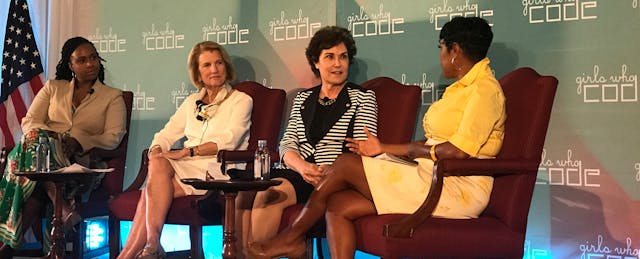Jacky Rosen, a former computer programmer and the current junior U.S. Senator from Nevada, says she “got into computers a little bit by accident.”
It was the late 1970s, and Rosen was pursuing a degree in psychology at the University of Minnesota. She was working on a research project, and her advisor suggested she take her data down to the math department and “tell them what you want—the guys will make you a program.”
Rosen did, and after being with those guys in the math department, she realized that, next time, she wanted to be able to do it herself. “I wanted to make these reports,” she told a room full of girls and women in tech on Wednesday at an event in Washington, D.C. “I wanted to do these things.”
So that’s what she learned to do. After finishing her undergraduate degree, Rosen later returned to school and earned an associate degree in computing and information technology, going on to work as a programmer and software developer for companies including Summa Corporation, Citibank and Southwest Gas.
“There weren’t very many women” in the field back then, she said, “and there still aren’t enough.”
But Rosen, sitting alongside Sen. Shelley Moore Capito from West Virginia and Rep. Ayanna Pressley from Massachusetts, encouraged the nearly 100 middle school, high school and college-aged girls in the audience to keep at it anyway, adding that “computers are creative, they’re dynamic, they’re detail-oriented”—just like them.
Rosen and about a dozen of her female colleagues in Congress, including Reps. Sharice Davids from Kansas and Rashida Tlaib from Michigan, attended the event on Capitol Hill Wednesday hosted by Girls Who Code to discuss policy solutions that could help close the gender gap in technology.
As part of that, Girls Who Code founder and CEO Reshma Saujani announced that the organization has been working with Rosen’s team to draft what she called the “first-ever federal Girls Who Code legislation to encourage states to start reporting on their gender diversity data.” The nonprofit has successfully promoted and helped pass laws that track gender diversity in computing in two states so far this year—first in Washington, then in Colorado—but this was the first mention that it would be headed for the federal level. Girls Who Code did not provide a timeline on when the bill would be introduced.

The legislation is an important component in closing the gender gap, Saujani said, because current efforts to expand computer science education—33 states have passed legislation in the last five years—are having either no impact or a negative impact on girls’ participation in computer science. It’s a trend the nonprofit examines in a new report, “The State of Girls in K-12 Computer Science Classrooms,” that was released in conjunction with Wednesday’s gathering.
“You can’t just put a computer lab or have a computer science class in a middle or elementary school and think everything is going to change. It doesn’t work that way,” Saujani said at the event. “Many girls and girls of color still feel unwelcome.”
Nationally, girls make up 37.5 percent of all students in K-12 computer science classes. For those from historically underrepresented populations, such as black, Latina and low-income girls, that number plummets to 15.5 percent (the rate would have to be 25 percent for their participation in computing to be proportional to their makeup of the population). Girls Who Code is committed to getting those numbers to reflect the gender makeup of the country. And it's not just the girls who stand to gain, Pressley said: "The power of diversity in STEM, in every industry and agency, means there'll be greater innovation because there are diverse perspectives."
A critical part of getting to gender parity in STEM fields, Saujani said, is having schools track and report the demographic data of their computer science classes. “You cannot change what you cannot measure,” she said. “If you’re not actually looking at the composition of these classrooms, you cannot improve them.”
Diversify CS, Diversify the Economy
In addition to tracking and publishing participation rates, Girls Who Code recommends that lawmakers consider policies to fund gender inclusion training for teachers, expand computer science education to all middle schools and increase girls’ exposure to women in tech who they can identify with and look up to.

West Virginia is one of a handful of states that already tracks female participation in computer science and STEM classes, Capito said at the event. “Because of that, our participation rate is higher than the national average,” by nearly two percentage points. The senator also noted that, as a state with an historically energy-based economy, West Virginia has been trying to find ways to diversify its economy.
“I want to see our young girls and young women lead the way in that diversification,” Capito said. “You don’t have to live in New York City or Silicon Valley to do these jobs. You can sit in Fairmont, West Virginia, and go and make a difference.”
In the seven years since its founding, Girls Who Code has taught computer skills to 185,000 girls, half of whom are black, Latina or come from low-income households. The nonprofit estimates that computer science could reach gender parity by 2027, but “to move faster, to reach every single girl in every town, every parish, every community,” Saujani said, “we need the government’s help.”


